When I was ten years old, my time was occupied playing with my Star Wars action figures in the yard, setting up jumps for my banana-seat bike and saving my weekly allowance for summer camping trips to the woods of Wisconsin.
Yesterday I met Tin, a Cambodian living in Battambang and a tuk-tuk driver for tourists. In 1975 he was orphaned and marched into a forced labor camp for children where he toiled for four years. His memories as a ten-year-old suffering under the Khmer Rouge contrast profoundly with my years in green, growing Iowa buoyed by comfort, care and stability.
Since I met Tin yesterday, I have been haunted by the profound difference of our respective childhoods, living not just on opposite ends of the globe but a universe apart. Here is his story.
Tin is just about my age, born in Phenm Penh in the mid-1960’s. In 1975 the capital city fell to Khmer Rouge communist forces after an arduous and bloody civil war. The next day the Khmer Rouge began evacuating all residents from Phenm Penh and the other cities to the country to work in forced-labor camps.
For weeks the roads were filled with the mass exodus from the cities: Women walked for days carrying crying infants and running out of food. Hospitals were emptied, the sick and infirm were forced onto the roads, some holding IV’s and being pushed in wheelchairs. Many elderly struggled and died in the forced march to the countryside. Year Zero had begun, ushering in a brutal new era of radical restructuring of Cambodian society into a peasant-dominated agrarian cooperative.
The Khmer Rouge rejected the rich cultural past of Cambodia as a suitable model for the new society. Schools were shuttered, money officially abandoned replaced by a “barter” system, libraries burned, Buddhist temples shelled and ancient monument sites scavenged for works projects. The borders were sealed, no one was allowed in or out. International aid assistance was denied. Anyone with an education, contacts with the former government or links to other countries, who spoke a foreign language, wore glasses, or lived in a city was considered “bourgeois” was taken away and likely killed.
The others were forced into labor camps structured by age and gender; families were torn apart with children and parents in opposite parts of the country. Conditions everywhere were appalling and treatment was brutal. Children were often questioned separately by the Khmer Rouge; they knew the young were less likely to cover up important family details. Anyone accused of insubordination or suspected of moral weakness was simply exterminated; there was no justice or rule of law.
Almost 2 million people were killed by the Khmer Rouge’s genocidal reign of terror. In fewer than four years, nearly one out of every four Cambodians died.
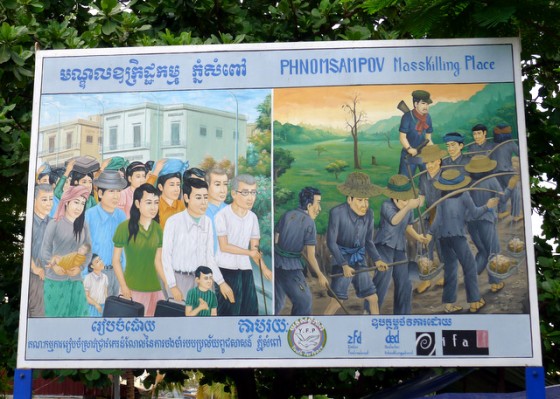
Tin was ten years old when this horror started. All of his family died with the exception of his younger sister. He lost his parents, grandparents, every older sibling. He was sent to Battambang province to toil in a child work camp. He told us what he did there: while the adults worked with often their bare hands to build irrigation canals and dykes in order to increase rice-production threefold (the opposite happened as widespread famine spread through the country), Tin was tasked with making fertilizer. For 12-15 hours a day his small hands cut brush, gathered fallen leaves and cow manure and mixed them in large bins. He collected human feces, placing buckets under latrine seats and carried the defecation to the compost pile. His voice still evokes the stench and degradation of this experience.
He ate a meager two meals a day, one at midday and one in the evening. It was insufficient for the physical labor he had to complete each day. He ate watery manioc or sweet potato porridge since most of the rice was exported or reserved for the ruling cadre in the nearly empty Phenm Penh. Tin recalls the terrible hunger of this period: people were gaunt and malnourished, he vividly remembers one mother who was too weak to seek medical attention for her staving infant. Tin watched as she sat listlessly watching her child die.
At his boy’s camp, once he saw a bowl and spoon in the field along with some rags of clothing. Earlier in the day, a boy he knew was caught stealing some food and was dragged off in the same direction by a Khmer Rouge militant for “re-education.” Tin knew even then at his young age that the other boy was killed at that very spot. His child eyes saw many corpses and many people he knew disappear without a trace. Even a desperately hungry friend died when he ate poisonous mushrooms he picked in the forest.
Tin described the weekly meetings that people in the work camps had to attend. Here people, often coerced, denounced their friends and neighbors of un-revolutionary behavior: someone who had uttered a word in French, someone who was seen with extra food, or someone who was caught reading a book or perceived as not working hard enough in the fields. The accused were taken away to reeducation camps, most were probably killed.
Sadly, personal vendettas and petty arguments ended up in such informant tragedies – Tin emphasized the paranoia that existed at the time; there was no one to trust in a shattered society. The regime maintained control through fear by pitting citizens against each other, and before long even the Khmer Rouge was attacking itself from the inside as distrust and infighting increased. They were desperate times indeed; Tin’s voice today carries the awful weight of loneliness and dread from those dark days.
This is the world Tin lived in from age 10 to 14 while the Khmer Rouge was in power. He did not go to school, nor did he eat nourishing meals or enjoy friends and neighbors. He did not have parents or siblings to turn to. The Khmer Rouge was distant and mysterious, he was told of supreme leadership called Angkar (“the Organization”) but he never saw pictures, he never knew names, he never heard anyone speak. It was years later after the Vietnamese invasion that brought down the Khmer Rouge that Tin first heard the name Pol Pot. Tin was an anonymous child toiling endless days on a brutal forced-labor camp of a faceless, craven regime.
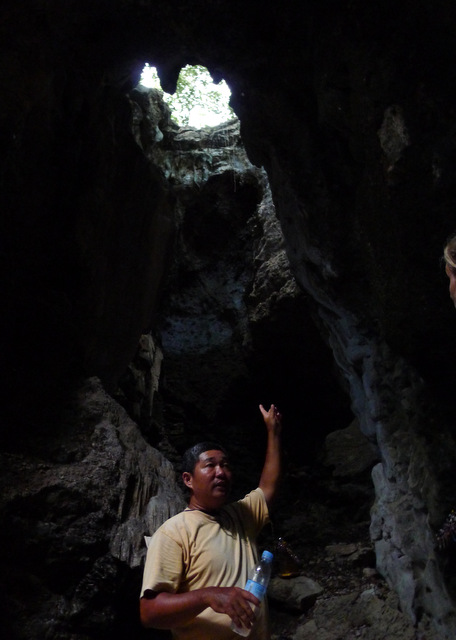
The most affecting part of my day was our visit to the Killing Cave, about 20 kilometers outside of Battambang. This prominent rock outcropping, Phnom Sampeau (Sailboat Mountain) features a Buddhist temple with magnificent views of the rich farmlands expanding in all directions below. The Khmer Rouge declared the mountain a military zone and closed it to the public. Tin remembers hearing hushed stories and strange sounds from Phnom Sampeau, always within view of his work camp.
After the Khmer Rouge fell, thousands of bones and decomposing bodies were piled in the caves lining the mountain. For years it was a center of torture and killing. Bodies were tossed alive into the cave, occasionally a grenade was dropped as well. We descended into one of the caves, the inside carved out from the explosions; bone fragments still emerge from the dark soil. A reclining Buddha, rebuilt after the war, sits prophetically alongside a caged stupa containing the remains of Khmer Rouge victims. It was dark, damp and sorrow weighed heavily in the air. I was standing in the middle of death, the awful stench of senseless genocide overbearing and real.
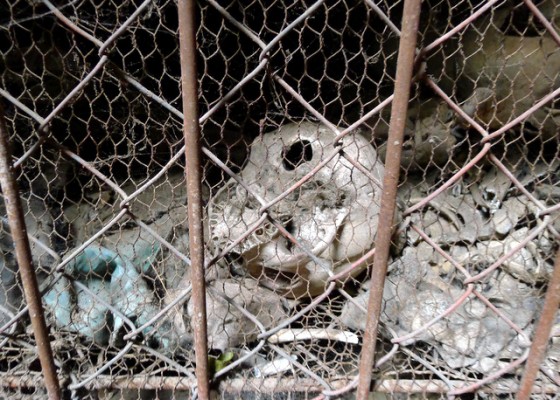
As we walked solemnly out of the cave, the normally talkative Tin broke the silence:
When it rains this cave is really foul. The dampness is thick, the air still and odor is oppressive.
There was nothing more to be said. This tragic resting place still is haunted by layer upon layer of restless souls that still surface in the rainy season, a shadowy chamber guarding the untold stories of unresolved killings. We climbed wordlessly to back to the trail.
Later I asked what happened after the Khmer Rouge fell. Tin explained the immediate chaos and hardship of trying to rebuild Cambodian society after years of mass killings, systematic brutality and the physical and mental destruction. There were reprisals, of course, during the first year before the new Vietnamese rulers were able to implement a stable government. Tin remembers that Khmer Rouge members were tracked down and killed in many cases. He said they were not difficult to identify: often they were of healthy weight while the rest of the population was starving, their hands did not show the rough scars and callouses of years of manual labor, and their feet often showed the black marks left over from wearing the rough soles made from old rubber tires (known as “Ho Chi Minh”sandals) which were standard issue for the Khmer Rouge rulers.
To this day many thousands have not been brought to justice, only the top leaders have been tried but many underlings live in masked shame of their complicit atrocities. And peace did not come easily or quickly; Khmer Rouge forces withdrew to the northwest after the Vietnamese invasion. Sporadic guerrilla fighting and insecurity dominated Battambang province until as late as 1996 after the Khmer Rouge secured government amnesty and fighters surrendered.

As a teenager Tin rebuilt his life in the 1980’s, first working for the militant Vietnamese regime planting land mines along the Thai border, later he worked in a brick factory where he met his wife. They had children. He finished school, learning Russian and studying as a geologist. But in the tough economic years of the 1990’s he could not find professional work and never built a career in his area of expertise. Today he drives a tuk-tuk for tourists who want to visit the sights around Battambang: the temples, the bamboo train, the 11th-century Angkor ruins, the killing caves.
Tin is incredibly smart, articulate and well-informed. Smiling and good natured, he is always serious about the history of the area, and careful to make sure we get a complete picture of Battambang, stopping to have us try the foods people eat (e.g. sweet sticky rice wood-fired in bamboo), the way they celebrate (e.g. he explained a typical Cambodian wedding with loud party tents set up on the streets), how the children are schooled and play in their neighborhoods.

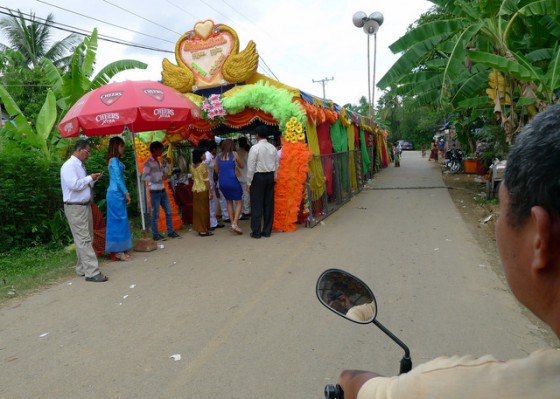
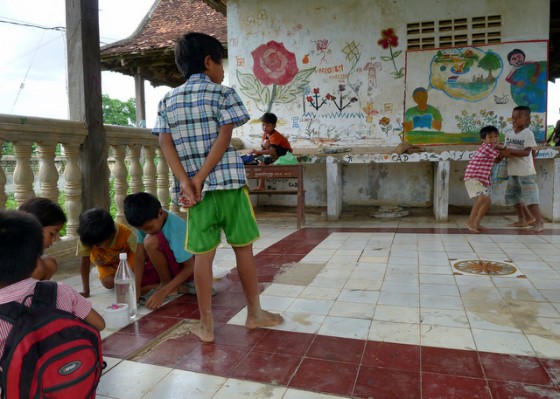
The first conversation I had with him was about elections in Cambodia: it was the day in which the commune elections were beginning with party dinners, parades, and active campaigning along the main avenues of Battambang. He was holding a leaflet of the Sam Rainsy Party, the main opposition to the ruling Cambodia’s Peoples Party. Since I am very interested in politics, I asked him what the Khmer pamphlet said. Tin patiently translated the main party platform items (“uphold morality and justice, treat ordinary people gently and do not discriminate, protect the lands of minority people, create assemblies of agriculture and fish management”, etc). Tin is engaged in his country as it builds a stable democracy out of the ashes of the Khmer Rouge. Despite the horrible years of his childhood, Tin is looking forward, not back.
Tin told me how he recently met a security guard in Battambang and learned he was formerly a Khmer Rouge soldier. This man’s father was a Khmer Rouge fighter who died in battle, a poor peasant with no formal education and only farm laborer skills. At the age of twelve (he is two years older than Tin), this boy was wearing the Khmer Rouge uniform and marched into Battambang in 1975. Twelve years old. A boy soldier, his short life dominated by Khmer Rouge propaganda and the death of his insurgent father.
And here’s Tin, who lost practically his entire family and his childhood under the regime that this man fought for and was a part of. Instead of turning away in anger and spite, Tin started talking to him and they shared their stories of the Khmer Rouge years. Over the course of several encounters with the man a friendship developed. Tin shares his books and introduced him to Tin’s nephew, the son of his younger sister, his only surviving family member. These two men learned that they have far more in common with each other than their diverging histories would suggest. I was left with a vibrant image of Tin and his new friend finding some common ground and a sliver of reconciliation to help them move forward, past the nightmares of their tragic childhoods.
I don’t know how the Cambodians are able to do this. The wounds of the Khmer Rouge bleed still; memories are painful but are slowly healing. Barely a generation has passed since the dark days of the Khmer Rouge, yet the Cambodians somehow find the strength to move forward.
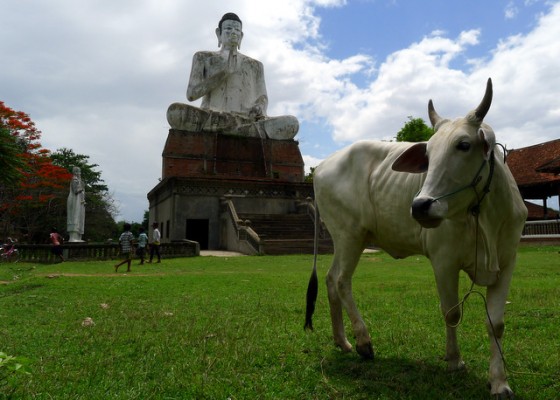
Maybe it is some special coding in their cultural DNA: their general good nature and resilience, faith in family, their openness and strength in community. Maybe it’s their Buddhism and belief in reincarnation, their spiritual understanding that life is suffering and good deeds will lead to more happiness in the next life. Maybe it’s a toughness they’ve developed over centuries of war and invasion, learning to coexist with different groups and adapt as new cultures. Perhaps these are all too simplistic, but I really don’t know how a people can move past something so horrible, so recent, so absurd. But the Cambodians seem to have found a way.
They discuss, they learn, they remember. Posters of the hardships and cruelty imposed on the Cambodian people under the Khmer Rouge appear on street billboards, it is discussed in elections and addressed in public awareness campaigns. Genocide and torture sites are preserved as memorial museums and free to all Cambodians, I personally saw the Khmer people among the many visitors. War Victims Hospitals are in every province, worthy teams of NGO’s and locals dedicate countless hours and resources to help repair, rebuild, and renew Cambodian society. It will take generations of patience and resolve.
And, significantly, they teach their children about the Khmer Rouge period. When I asked a small boy in a village what the crumbling concrete building in the center of his hamlet was, an imposing but dilapidated structure towering over all the squat wooden huts, he simply said “It was Khmer Rouge, they were very bad, they hurt us” — he may not remember, but he knows.
I am very thankful to have met Tin in Battambang. His directness and sincerity brought me closer to the horrors of recent Cambodian history, more so than the exceptional genocide and torture museums in Phenm Penh. He added immediacy, a face and a story that paints an intense picture of the suffering and senseless tragedy of the Khmer Rouge as experienced by someone very real.

Tin shared with us a final story as we passed a large statue of an ancient Khmer king on the outskirts of town. He explained that Battambang means “disappearing stick,” named after a powerful bludgeon used by the Khmer king to achieve and maintain power in his kingdom. He dreamed that a holy man on a white horse would overthrow him, so the king rounded up all the holy men to be killed. But when the holy men started to appear, the gods intervened and made the bloody bludgeon disappear. Rendered powerless, the king fled never to be seen again.
Let’s all work to ensure that the killing stick of Battambang remains forever vanished.
Tin’s story is every Cambodian’s story who suffered under the Khmer Rouge from 1975-1979. I encourage everyone to learn more about Cambodian genocide by visiting the Documentation Center of Cambodia (www.dccam.org) or Yale University’s Cambodian Genocide Project (www.yale.edu/cgp).
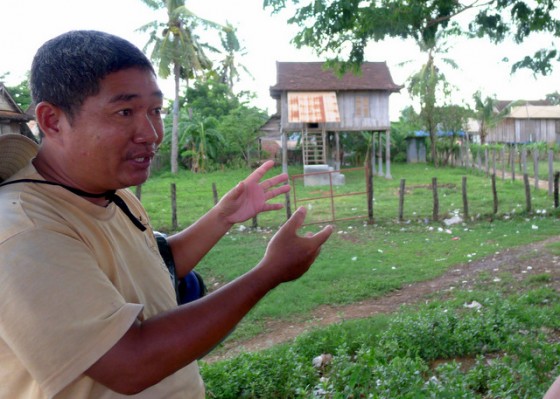
Amazing story Peter. It is hard to even fathom how cruel humans can be to one another. What happens in the mind of the “torturer” that makes them turn off that human side. I am so glad that Tin is mending and that he was willing to share his story with you. The human spirit is boundless sometimes. A lesson for us all…
Thank you for taking the time and the heart to write this. Ame
Thanks, Amy. Yes, it is an amazing story of one person living in dreadful, unimaginable circumstances. I’m now just finishing reading First They Killed My Father by Loung Ung, a similarly tragic memoir by a young Cambodian girl who barely survived the Pol Pot years; she too lost most of her family and there are many parallels with what Tin shared with me.
Like Tin, she survived. Thanks to the generosity and opportunities of our country, she built a new life in America. This make me proud. Our nation has an enormous capacity to help when it matters.
I think the international Khmer Rouge tribunal is a farce at best. There is no way that trying five surviving members of the Khmer Rouge leadership will bring either justice or closure to the millions of innocent victims who have perished or are still reeling from their genocidal rule. I think the focus should be on education and raising awareness so that similar atrocities do not happen again.
I know this tour guide. he is my neighbor
Lucky you, David, I really enjoyed my time in Battambang thanks largely to your neighbor 🙂